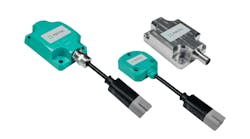It's not okay to grab the nearest roll of wire off the shelf and begin to wire a control panel or machine. There are many requirements to follow, including ampacity, color and many other characteristics. Much of the requirements have to do with control circuit conductor protection, against both overcurrent and short circuit, and the type of wires used inside and outside of a control enclosure. When specifying wire and connectors, it is best to take a step back to the basics and start with the standards that must be followed.
The National Fire Protection Association (NFPA) has a lot to say about codes and standards related to electrical and fire safety. NFPA 70: National Electrical Code (NEC) details the requirements for safe electrical design and installation, and it explains how to protect people and property from electrical hazards. If you are designing control systems, you should probably have a heavy, hardbound copy of this standard front and center on your desk.
More importantly, any electrical designer, machinery manufacturer, installer or others working with industrial equipment must have a copy of NFPA 79: Electrical Standard for Industrial Machinery. NFPA 79 provides safeguards for industrial machinery and protects operators, equipment and facilities from electrical hazards. It also addresses requirements to keep machinery from burning down the factory. All industrial machine wiring, 600 V or less, from the control enclosure's main disconnect to the field devices on the machine, are included in this standard.
Too much current in a conductor can cause a fire. Other than a few exceptions, electrical conductors must be protected from overcurrent based on the conductor ampacity. There are ampacity tables in NFPA 79 for grounding and binding conductors, as well as power and control circuit conductors. The control circuit design at the main electrical disconnect and branch circuit fusing determines the ampacity—the current-carrying capability of the wire—and the related wire gauge referred to as American wire gauge (AWG) in the United States. Of course, the conductor ampacity table needs to be adjusted based on ambient temperature, insulation temperature rating and the number of current-carrying conductors in a bundle or wire duct, for example.
In addition to correction and adjustment factors to the ampacity, there are other wire current rating requirements. Motor circuit conductors to a single motor must be at 125% or more of the motor full-load current rating. And 125% is added to all resistance heating loads, as well. That's 125% of the largest motor plus 125% of the resistance heating load total plus the sum of all the full-load currents connected to the conductor. It adds up and may require additional fusing to reduce conductor size.
ALSO READ: Consider machine integration in the design phase
Speaking of exceptions, there are more than a few, especially with regard to conductor sizing. Power circuits, such as feeder and branch-circuit conductors feeding a disconnect, must be a minimum of 14 AWG based on electrical equipment requirements. Yet control circuit conductor sizes of 14, 16 and 18 AWG are considered protected by a 20-A or less overcurrent device. And control circuit conductors of these sizes inside a control cabinet have even higher ampacities. No wonder some factory's electrical specifications require a minimum of 14 AWG wire.
These rules for selection of proper wire ampacity selection are spread throughout several sections of NFPA 79, including protection of equipment; equipment grounding; conductors, cables and flexible cords; and wiring practices sections.
Clearly, there are codes to understand when specifying wire. Not only must it meet overcurrent and short-circuit requirements, the voltage rating, insulation type and number of wire strands must be considered, as well as flexing applications, wire color, connections and routing.
A wire or cable insulation voltage rating must be considered for use in the circuit and the installation in the control panel. A cable rated at 300 V obviously cannot connect to a 480 Vac motor circuit, but it also cannot run in the same conduit or raceway as the 480 Vac circuit wires or cables.
The wires and cables must also have flame-retardant properties and be suitable for use within certain temperature limits. Check out the heat-, moisture- and oil-resistant thermoplastic insulation of machine tool wire (MTW) and thermoplastic high heat-resistant nylon-coated (THHN) wire, among others. You'll need to specify the correct one.
The wire, cables and flexible cord specified must be selected based on the applications. These conductors are identified for their intended uses. To start, they must be stranded, soft-annealed copper. Whether a nonflexing, flexing or constant flex application, there are a minimum number of conductor strand requirements for that.
Specifying the correct conductor color is important, as well. The NFPA 79 specifies black for ungrounded power circuits, green with or without a yellow strip for ground, red for 120 Vac, white for 120 Vac grounded common, blue for a dc control circuit and white with blue strip for dc grounded common and others. Follow these color standards in the United States, but check the European codes, as their wire colors are different.
There are many requirements for connections and terminals, as well. For example, if the conductor exits the control enclosure, it should be connected to a terminal. There are pages of requirements for wiring practices in NFPA 79. Purchase this code or similar and study up. If not, the smell of an electrical fire may make it into your future control system design.






